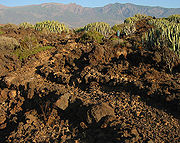
Malpaís de Güímar
Encyclopedia

Volcanic cone
Volcanic cones are among the simplest volcanic formations. They are built by ejecta from a volcanic vent, piling up around the vent in the shape of a cone with a central crater. Volcanic cones are of different types, depending upon the nature and size of the fragments ejected during the eruption...
, subsidiary cones, and several basalt
Basalt
Basalt is a common extrusive volcanic rock. It is usually grey to black and fine-grained due to rapid cooling of lava at the surface of a planet. It may be porphyritic containing larger crystals in a fine matrix, or vesicular, or frothy scoria. Unweathered basalt is black or grey...
ic lava
Lava
Lava refers both to molten rock expelled by a volcano during an eruption and the resulting rock after solidification and cooling. This molten rock is formed in the interior of some planets, including Earth, and some of their satellites. When first erupted from a volcanic vent, lava is a liquid at...
flows in the Güímar municipality
Güímar
Güímar is the name of a municipality, town, and valley in the eastern part of the Spanish island of Tenerife, one of the Canary Islands, and part of Santa Cruz de Tenerife...
on the island of Tenerife
Tenerife
Tenerife is the largest and most populous island of the seven Canary Islands, it is also the most populated island of Spain, with a land area of 2,034.38 km² and 906,854 inhabitants, 43% of the total population of the Canary Islands. About five million tourists visit Tenerife each year, the...
, in the Canary Islands
Canary Islands
The Canary Islands , also known as the Canaries , is a Spanish archipelago located just off the northwest coast of mainland Africa, 100 km west of the border between Morocco and the Western Sahara. The Canaries are a Spanish autonomous community and an outermost region of the European Union...
, (Spain
Spain
Spain , officially the Kingdom of Spain languages]] under the European Charter for Regional or Minority Languages. In each of these, Spain's official name is as follows:;;;;;;), is a country and member state of the European Union located in southwestern Europe on the Iberian Peninsula...
). They total in area about 290 hectares. The lava flows are quite recent, less than 10,000 years old of the typical aā type. The large cone is called Montaña Grande (Big Mountain) and reaches a height of 276 m (906 ft).
Geography
The Malpaís de Güímar were formed by a series of volcanic eruptions, the most recent and most evident occurring from fissures in the side of the Montaña Grande cone less than 10,000 years ago. However, two peaks from former eruptions stand above the lave plain, Montaña de la Mar (Mountain of the Sea) and Las Morras del Corcho (Cork Bluff). In addition to aa lava flows, there have been pyroclasticPyroclastic rock
Pyroclastic rocks or pyroclastics are clastic rocks composed solely or primarily of volcanic materials. Where the volcanic material has been transported and reworked through mechanical action, such as by wind or water, these rocks are termed volcaniclastic...
eruptions of ash and volcanic bomb
Volcanic bomb
A volcanic bomb is a mass of molten rock larger than 65 mm in diameter, formed when a volcano ejects viscous fragments of lava during an eruption. They cool into solid fragments before they reach the ground. Because volcanic bombs cool after they leave the volcano, they do not have grains...
s that actually formed the various cones. The crater of Montaña Grande is about 300 meters in diameter and about 50 meters deep. It also has a certain asymmetry, being wider towards leeward due to the action of the wind during its period of formation. The shore line has eroded back since the last eruptions and beaches have formed in a few areas. In places lava tube
Lava tube
Lava tubes are natural conduits through which lava travels beneath the surface of a lava flow, expelled by a volcano during an eruption. They can be actively draining lava from a source, or can be extinct, meaning the lava flow has ceased and the rock has cooled and left a long, cave-like...
s have been exposed. Notable is Cueva Honda (Deep Cave) which was formed by a large gas bubble within a lave tube.

